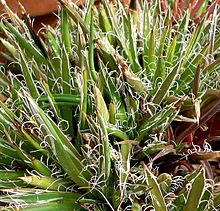Agave parviflora is a species of succulent perennial flowering plant in the asparagus family, known by the common names Santa Cruz striped agave, smallflower century plant, and small-flower agave. It is native to Arizona in the United States and Sonora in Mexico.[2]
| Agave parviflora | |
|---|---|

| |
| Scientific classification | |
| Kingdom: | Plantae |
| Clade: | Tracheophytes |
| Clade: | Angiosperms |
| Clade: | Monocots |
| Order: | Asparagales |
| Family: | Asparagaceae |
| Subfamily: | Agavoideae |
| Genus: | Agave |
| Species: | A. parviflora
|
| Binomial name | |
| Agave parviflora | |
Description edit
The specific epithet parviflora means "small-flowered".[3]
This agave produces a small rosette up to 25 cm (10 in) tall by 20 cm (8 in) wide. The succulent leaves are up to 20 cm (8 in) long and are a waxy dark green with white markings. The leaf margins have peeling fibers. The plant produces an inflorescence 1–2 m (3–7 ft)tall with cream or pale yellow flowers in summer.[4] The flowers are pollinated by bees such as bumblebees.[2] In bloom, hummingbirds are attracted by this agave.[5] It lives between 10-15 years before flowering.[6] When it flowers, it grows an up to 7 feet tall spike-like stalk with light yellow or cream colored flowers. The flowers come in groups of 1-4 flowers, mostly in spring. After blooming, the agave dies.[7] The fruit is small ovoid capsules that is between 6-10 millimeters in diameter. The seeds are wedge shaped and half round.[8] The plant has slow to moderate growth. The leaves are strongly whorled and grow tightly around ramets. The leaves are also narrow and stiff and taper to a sharp point. The texture is medium coarse. If the roots are chronically damp, A. parviflora might get Black root rot (Thielaviopsis basicola).[9]
Subspecies of the plant include ssp. parviflora[10] and ssp. densiflora.[11]
Distribution and Habitat edit
It grows in semi-desert grasslands, oak woodlands, and other dry and rocky places.[9] It is a rare species that has limited distribution in Arizona and parts of Northern Mexico. The state of Arizona considers Agave parviflora as endangered and protects it as highly safeguarded. The US Forest Service designated it as a Sensitive Species. Since this species is federally endangered, it is illegal to collect this plant.[6] It commonly grows at elevations between 3,000 to 5,000 feet (900 to 1,520 m).[7]
Cultivation edit
This species is the smallest agave in Arizona and is sought by collectors. For this reason the species has declined in its native habitat. There are only about two dozen natural populations in Arizona. Other threats to the species include road construction and mining.[2] However, because the population appears to be stable and it grows in several protected areas, it is not considered by the IUCN to be threatened.[1]
The plant is valued in cultivation and has gained the Royal Horticultural Society's Award of Garden Merit.[12][13]
Uses edit
The leaves and the heart of the plant are baked and eaten. This species is the sweetest and most edible of Agave. However, it is commonly not eaten as it is also the smallest of its genus. It is used to make the distilled liquor Mezcal. Mezcal can be made out of any Agave species, although around 7 species are the most common and favorited.[14]
References edit
- ^ a b Hodgson, W.; Puente, R.; Salywon, A. (2020). "Agave parviflora". IUCN Red List of Threatened Species. 2020: e.T115689669A116354298. doi:10.2305/IUCN.UK.2020-1.RLTS.T115689669A116354298.en. Retrieved 20 November 2021.
- ^ a b c "Center for Plant Conservation - Saving Endangered Plants". Center for Plant Conservation. Retrieved 2023-08-21.
- ^ Harrison, Lorraine (2012). RHS Latin for gardeners. United Kingdom: Mitchell Beazley. p. 224. ISBN 9781845337315.
- ^ RHS A-Z encyclopedia of garden plants. United Kingdom: Dorling Kindersley. 2008. p. 1136. ISBN 978-1405332965.
- ^ "Search Tree Collections". apps.cals.arizona.edu. Retrieved 2023-08-21.
- ^ a b "Smallflower Century Plant". www.fs.usda.gov. Retrieved 2023-08-21.
- ^ a b WoS (2017-07-02). "Agave parviflora (Smallflower Century Plant)". World of Succulents. Retrieved 2023-08-21.
- ^ "Agave parviflora". www.llifle.com. Retrieved 2023-08-21.
- ^ a b "Scientific: Agave parviflora (Synonyms: Agave parviflora ssp. parviflora, Agave hartmanii)". www.public.asu.edu. Retrieved 2023-08-21.
- ^ Agave parviflora. Flora of North America.
- ^ Starr, G. and T. R. Van Devender. (2011). Agave parviflora subspecies densiflora. A newly found treasure from the Sierra Madre in Eastern Sonora, Mexico.[permanent dead link] Cact Succ J (US) 83(5) 224-31.
- ^ "RHS Plant Selector - Agave parviflora". Retrieved 23 February 2020.
- ^ "AGM Plants - Ornamental" (PDF). www.rhs.org. Royal Horticultural Society. November 2018. p. 3. Retrieved 27 February 2020.
- ^ "Agave parviflora - Useful Temperate Plants". temperate.theferns.info. Retrieved 2023-08-21.

